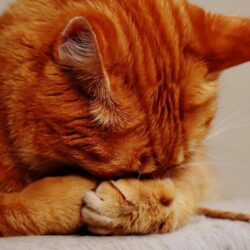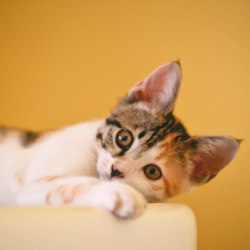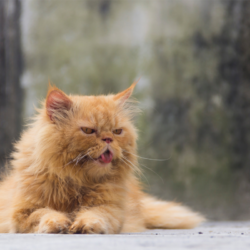Renal failure is a common condition in cats, particularly older felines. This condition, which is often initially asymptomatic, can have serious consequences if not treated in time. In this article, we take an in-depth look at this dreaded disease, its symptoms, the means of diagnosis, the treatments available and methods of prevention to ensure a better quality of life for our feline companions.
What causes renal failure?
Kidney failure kills many cats every year. It’s a dreaded disease, often asymptomatic in its early stages. The kidneys play a crucial role in eliminating toxins from the blood, particularly urea. When these organs no longer function properly, these toxins accumulate, causing a variety of health problems.
It is important to distinguish between acute renal failure (ARF) and chronic renal failure (CRF). AKI occurs suddenly, often due to infection, poisoning (such as the ingestion of antifreeze or certain poisonous plants such as lilies) or damage to the kidneys. CKD, on the other hand, is a progressive and irreversible disease that particularly affects older cats. The causes of CKD are varied, ranging from genetic predisposition (as in Persian cats) to unknown factors. This chronic form of the disease can progress over several months or years, gradually reducing the functionality of the kidneys.
As well as eliminating toxins, the kidneys regulate the body’s minerals and blood pressure and produce vital hormones. Kidney failure therefore leads to major imbalances in the body. The first clinical signs generally appear when more than 75% of the nephrons are malfunctioning, making the disease difficult to detect early. Diagnosing chronic renal failure means that it is irreversible, but treatments can slow its progression and relieve symptoms.
What are the symptoms in cats?
Acute renal failure (ARF) is a sudden failure of kidney function. The main causes include pyelonephritis (kidney infection), kidney damage, repeated urinary problems and kidney cancer. Symptoms of AKI often vary and include anorexia, apathy, digestive disorders such as diarrhoea and vomiting, and severe dehydration that may be accompanied by hypothermia. In the event of irreversible kidney damage, the cat will auto-intoxicate, rendering treatment ineffective.
Chronic renal failure (CRF) mainly affects ageing cats. Initially, the disease is asymptomatic and can only be detected by blood tests. Early symptoms include increased water consumption and urination. In the intermediate phase, clinical signs become more apparent: vomiting, diarrhoea, dehydration, anaemia, mouth ulcers and high blood pressure. In the terminal phase, the cat’s general condition deteriorates considerably, with anorexia, extreme emaciation and worsening digestive problems. Blood urea and creatinine levels rise sharply, potentially leading to a uraemic coma.
Symptoms of chronic renal failure also include weight loss, lack of appetite and lethargy. Cats may drink and urinate more frequently at first, then less as the disease progresses. A veterinary consultation is necessary to establish a diagnosis and set up a suitable treatment plan.
How is the disease diagnosed?
Diagnosis of renal failure in cats is based on several clinical and paraclinical examinations. The vet will begin by carrying out a blood test to detect markers of renal dysfunction such as urea and creatinine. These parameters increase when renal function is impaired, but only become significant at an advanced stage of the disease.
For earlier diagnosis, measurement of symmetrical dimethylarginine (SDMA ) is recommended. The concentration of this substance increases as soon as renal filtration falls by 25%, well before the symptoms of chronic renal failure appear. Regular monitoring of SDMA can therefore enable early detection of the disease.
In addition to blood tests, a urinalysis is performed to assess urine concentration and detect the presence of underlying proteins or infections. Low urine density is a sign of renal dysfunction.
Renal ultrasound is a valuable diagnostic tool, enabling the kidneys to be visualised and structural abnormalities or signs of nephropathy to be detected. This examination is particularly useful for assessing the extent of damage and determining whether immediate intervention is necessary, especially in cases of suspected poisoning.
Finally, the vet may measure blood pressure and carry out other specific tests to check for the presence of anaemia or other complications associated with kidney failure. These additional tests are essential to establish an accurate diagnosis and a suitable treatment plan, aimed at slowing the progression of the disease and improving the cat’s quality of life.
What treatments are available?
The treatment of renal failure in cats varies according to the severity of the disease. Diagnosing renal failure early enables a change of diet to be initiated , which is a great help. Formulating special diets for cats with CKD with low protein and phosphorus levels reduces the burden on the kidneys and provides the necessary nutrients.
In cases of acute renal failure, intravenous infusion is often necessary to rapidly rehydrate the cat and restore temporary renal function. Veterinarians monitor kidney values and urine output closely to adjust treatment accordingly.
Dietary supplements, such as omega-3s, can be used to reduce oxidative damage to the kidneys. Other supplements, such as Ipakitine, help to alleviate nephritic pain and reduce the absorption of uraemic waste
Cats suffering from kidney failure can also benefit from appetite stimulants such as mirtazapine. Mirtazapine helps to control nausea and encourage regular feeding. Antacids such as famotidine or omeprazole are used to prevent gastrointestinal erosions caused by urea accumulation.
Finally, regular monitoring of kidney values by taking blood samples every six months is essential to adjust treatment and slow the progression of the disease. Annual veterinary visits are also recommended to monitor the progress of the disease and make any necessary adjustments to the treatment plan.
What can be done to prevent the disease?
Prevention of renal failure in cats is mainly based on regular monitoring and a healthy lifestyle. An annual blood test is recommended from the age of 7 to 8 years. This enables any signs of kidney dysfunction to be detected early. Depending on the results, the vet may suggest more frequent checks.
The right diet is crucial for older cats. Opt for lower-protein diets specially formulated for senior cats. Also make sure your cat always has access to fresh water to maintain good hydration. A mixed diet, combining kibbles and pâtée, is often beneficial.
Phytotherapy can also play a role in preventing kidney disease. Plants such as orthosiphon, desmodium and dandelion have diuretic and depurative properties that support kidney function. Blackcurrants and cranberries, rich in antioxidants, help prevent urinary tract infections.
It’s essential to monitor your cat’s eating and drinking habits. Note any changes in water intake or appetite, and consult a vet quickly if in doubt. Older cats should be weighed regularly to detect any unexplained weight loss, a potential sign of kidney dysfunction.
Finally, regular veterinary check-ups allow you to keep a close eye on your cat’s health and detect any abnormalities at an early stage. If chronic kidney disease is diagnosed, rigorous monitoring and dietary adjustments can considerably improve your cat’s quality of life and extend its lifespan.





